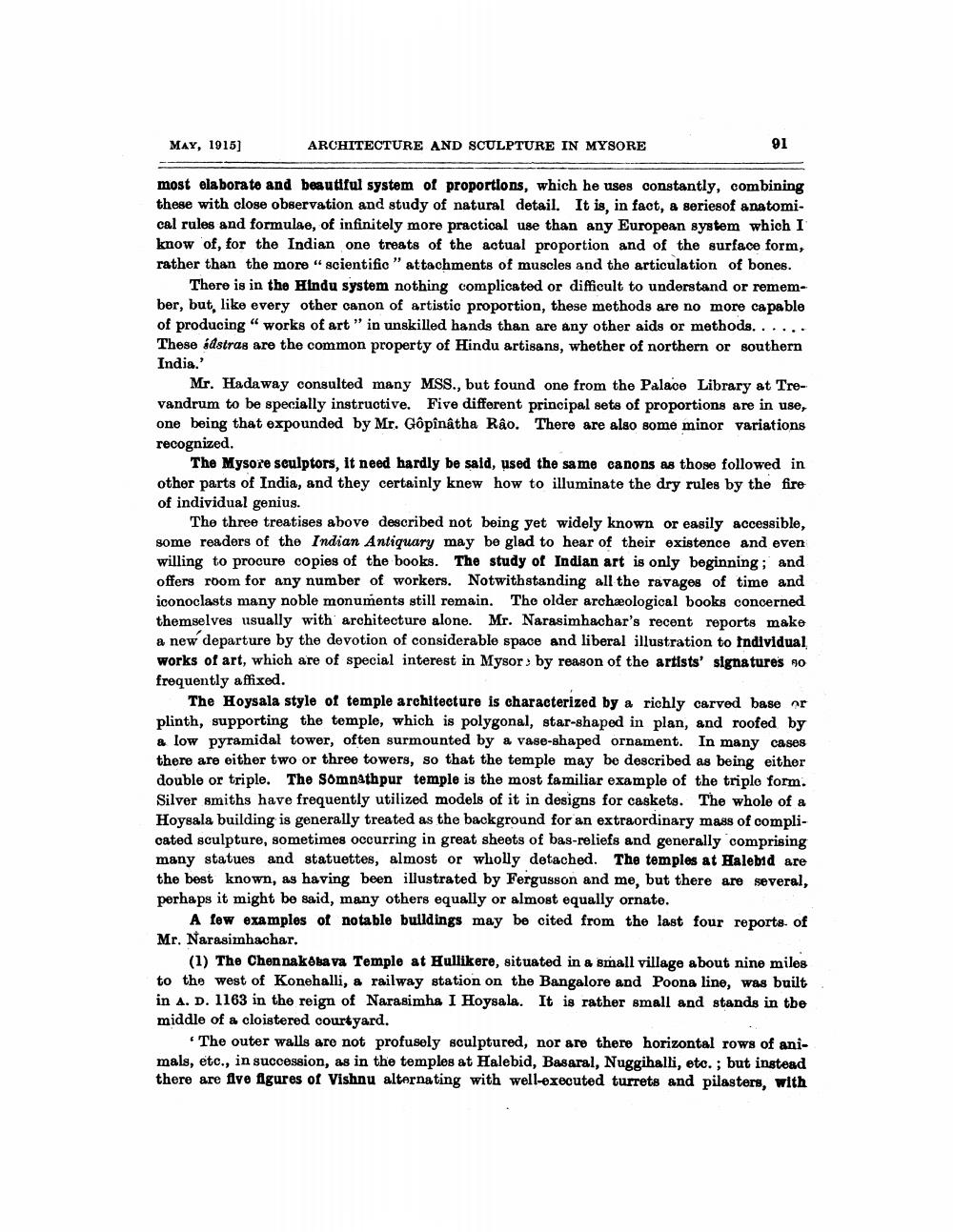________________
MAY, 1915]
ARCHITECTURE AND SCULPTURE IN MYSORE
91
most elaborate and beautiful system of proportions, which he uses constantly, combining these with close observation and study of natural detail. It is, in fact, a seriesof anatomical rules and formulae, of infinitely more practical use than any European system which I know of, for the Indian one treats of the actual proportion and of the surface form, rather than the more " scientific "attachments of muscles and the articulation of bones.
There is in the Hindu system nothing complicated or difficult to understand or remember, but, like every other canon of artistic proportion, these methods are no more capable of producing“ works of art" in unskilled hands than are any other aids or methods. ..... These adstras are the common property of Hindu artisans, whether of northern or southern India.'
Mr. Hadaway consulted many MSS., but found one from the Palace Library at Trevandrum to be specially instructive. Five different principal sets of proportions are in use, one being that expounded by Mr. Gopinatha Rao. There are also some minor variations recognized.
The Mysore sculptors, it need hardly be said, used the same canons as those followed in other parts of India, and they certainly knew how to illuminate the dry rules by the fire of individual genius.
The three treatises above described not being yet widely known or easily accessible, some readers of the Indian Antiquary may be glad to hear of their existence and even willing to procure copies of the books. The study of Indian art is only beginning and offers room for any number of workers. Notwithstanding all the ravages of time and iconoclasts many noble monuments still remain. The older archæological books concerned themselves usually with architecture alone. Mr. Narasimhachar's recent reports make a new departure by the devotion of considerable space and liberal illustration to Individual works of art, which are of special interest in Mysor, by reason of the artists' signatures o frequently affixed.
The Hoysala style of temple architecture is characterized by a richly carved base nr plinth, supporting the temple, which is polygonal, star-shaped in plan, and roofed by & low pyramidal tower, often surmounted by a vase-shaped ornament. In many cases there are either two or three towers, so that the temple may be described as being either double or triple. The Somnathpur temple is the most familiar example of the triple form. Silver smiths have frequently utilized models of it in designs for caskets. The whole of a Hoysala building is generally treated as the background for an extraordinary mass of complicated sculpture, sometimes occurring in great sheets of bas-reliefs and generally comprising many statues and statuettes, almost or wholly detached. The temples at Halebid are the best known, as having been illustrated by Fergusson and me, but there are several, perhaps it might be said, many others equally or almost equally ornate.
A few examples of notable buildings may be cited from the last four reports of Mr. Narasimhachar.
(1) The Chen nakebava Temple at Hullikere, situated in a small village about nine miles to the west of Konehalli, a railway station on the Bangalore and Poona line, was built in A. D. 1163 in the reign of Narasimha I Hoysala. It is rather small and stands in the middle of a cloistered courtyard.
The outer walls are not profusely sculptured, nor are there horizontal rows of animals, etc., in succession, as in the temples at Halebid, Basaral, Nuggihalli, etc.; but instead there are five figures of Vishnu alternating with well-executed turrets and pilasters, with




